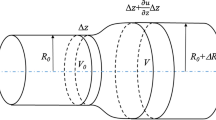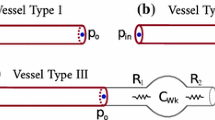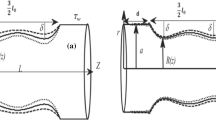Abstract
In order to better understand the effect of initial stress in blood flow in arteries, a theoretical analysis of wave propagation in an initially inflated and axially stretched cylindrical thick shell is investigated. For simplicity in the mathematical analysis, the blood is assumed to be an incompressible inviscid fluid while the arterial wall is taken to be an isotropic, homogeneous and incompressible elastic material. Employing the theory of small deformations superimposed on a large initial field the governing differential equations of perturbed solid motions are obtained in cylindrical polar coordinates. Considering the difficulty in obtaining a closed form solution for the field equations, an approximate power series method is utilized. The dispersion relations for the most general case of this approximation and for the thin tube case are thoroughly discussed. The speeds of waves propagating in an unstressed tube are obtained as a special case of our general treatment. It is observed that the speeds of both waves increase with increasing inner pressure and axial stretch.
Similar content being viewed by others
Literature
Atabek, H. B. and H. S. Lew. 1966. “Wave Propagation Through a Viscous Incompressible Fluid Contained in an Initially Stressed Elastic Tube.”Biophys. J. 7, 480–503.
— 1968. “Wave Propagation Through a Viscous Fluid Contained in a Tethered, Initially Stressed Orthotropic Elastic Tube.”Biophys. J. 8, 626–649.
Attinger, E. O. 1964.Pulsatile Blood Flow. New York: McGraw-Hill.
Bergel, H. d. 1961. “The Static Elastic Properties of the Arterial Wall.”J. Physiol. 156, 445–457.
Cox, R. H., 1975. “Anisotropic Properties of the Canine Carotid Arteryin Vitro.”J. Biomech.,8, 293–300.
Demiray, H. 1976. “Some Basic Problems in Biophysics.”Bull. math. Biol. 38, 701–711.
— 1985. “Effects of Twist on Pulse Waves in Arteries.”Bull. math. Biol. 47, 495–502.
Eringen, A. C. and E. S. Suhubi. 1974.Elastodynamics, Vol.I New York: Academic Press.
Fen, W. O. 1957. “Changes in Length of Blood Vessels on Inflation.” InTissue Elasticity J. Remington (Ed.), pp. 154–167. Washington, D.C.: American Physiological Society.
Fung, Y. C., K. Fronek and P. Patitucci. 1979. “Pseudoelasticity of Arteries and the Choice of its Mathematical Expression.”Am. J. Physiol. H, 620–631.
— 1984.Biodynamics: Circulation. New York: Springer.
Green, A. E. and W. Zerna. 1968.Theoretical Elasticity. Oxford: Clarendon Press.
Kuiken, G. D. C. 1984. “Wave Propagation in a Thin Walled Liquid-filled Initially Stressed Tube.”J. Fluid Mech.,141, 289–308.
Lambossy, P. 1951. “Apercu historique et critique sur le probleme de la propagation des ondes dans un liquide compressible enferme dans un tube elastique.”Helv. Physiol. Acta 9, 145–161.
Lawton, R. W. 1955. “Measurements on the Elasticity and Damping of Isolated Aortic Strips in the Dog.”Circulation Res. 3, 403–408.
McDonald, D. A. 1966.Blood Flow in Arteries. Baltimore: Williams & Wilkins.
Mirsky, I. 1967. “Wave Propagation in a Viscous Fluid Contained in an Orthotropic Elastic Tube.”Biophys. J. 7, 165–186.
Morgan, G. W. and J. P. Kiely. 1954. “Wave Propagation in a Viscous Liquid Contained in a Flexible Tube.”J. acoust. Soc. Am. 26, 323–328.
Rachev, A. I. 1980. “Effect of Transmural Pressure and Muscular Activity on Pulse Waves in Arteries.”J. Biomechanical Engr. ASME 102, 119–123.
Rubinow, S. I. and J. B. Keller. 1971. “Wave Propagation in a Fluid-filled Tube.”,J. acoust. Soc. Am. 50, 198–223.
Simon, B. R., A. S. Kobayashi, D. E. Strandness and C. A. Wiederhielm. 1972. “Re-evaluation of Arterial Constitutive Laws.”Circulation Res. 30, 491–500.
Skalak, R. 1966. “Wave Propagation in Blood Flow.” InBiomechanics Symposium, Y. C. Fung (Ed.), pp. 20–40. New York: Am. Soc. Mech. Engrs.
Vaishnav, R. N., J. T. Young, J. S. Janicki and D. J. Patel. 1972. “Nonlinear Anisotropic Elastic Properties of the Canine Aorta.”Biophys. J. 12, 1008–1027.
Womersley, J. R. 1957. “An Elastic Tube Theory of Pulse Transmission and Oscillatory Flow in Mammalian Arteries.” W.A.D.C. Technical report, TR56-614.
Author information
Authors and Affiliations
Rights and permissions
About this article
Cite this article
Erbay, H.A., Erbay, S. & Demiray, H. Pulse waves in prestressed arteries. Bltn Mathcal Biology 49, 289–305 (1987). https://doi.org/10.1007/BF02460121
Received:
Issue Date:
DOI: https://doi.org/10.1007/BF02460121




